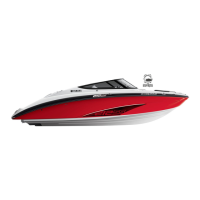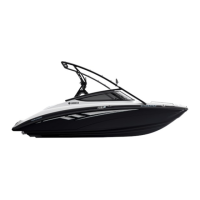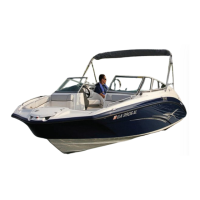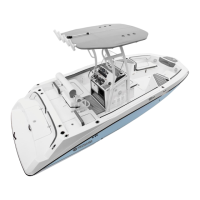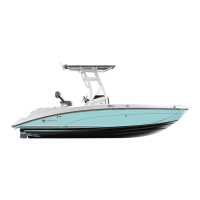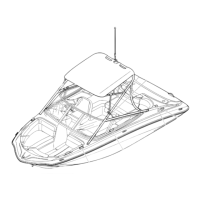Features & Functions Page: 29 Steering Explanation of how to steer the boat using the steering wheel and jet nozzles.
Tilt Lever Instructions for adjusting the tilt of the steering wheel for optimal comfort.
Main Switches Description of the main switches controlling ignition and electrical circuits.
Gauges Explanation of the boat's gauges, including LCD screens and their functions.
Switches Description of various switches like Blower, Bilge Pump, Lights, and Horn.
No Wake Mode Explanation of the No-Wake Mode system for low-speed maneuvering.
Accessory Outlet Information on the 12VDC accessory outlet and its usage precautions.
Engine Hood Procedure for opening and closing the engine hood.
Rear Walk-Through Guidance on accessing the stern patio area via the rear walk-through.
Swim Platform Information about the swim platform, including ladder use and carbon monoxide hazard.
Operation Page: 55 Fuel and Oil Guidelines for using the correct fuel and oil, including safety precautions.
Engine Oil Instructions on checking and maintaining the engine oil level.
Stopping Information on how the boat stops and the need for throttle to steer.
Docking Steps and precautions for safely docking the boat.
Leaving a Dock Guidance on safely maneuvering the boat away from a dock.
Beaching Procedures and warnings for safely beaching the boat.
Anchoring Step-by-step guide on how to anchor the boat safely and effectively.
Trailering Safety guidelines and procedures for trailering the boat.
Hitch Information on selecting and using the correct hitch for safe trailering.
Launching Recommended procedure for safely launching the boat from a trailer.
Loading Procedure for safely loading the boat onto the trailer.
Lifting Guidelines for safely lifting the boat without a trailer.
Maintenance and Care Page: 91 Storage Preventative maintenance procedures for storing the boat for extended periods.
Fuel System Instructions for preparing the fuel system for storage and use.
Lubrication Guidance on lubricating specific areas of the boat for smooth operation.
Battery Switch Information on operating the battery switch for power management.
Battery Procedures for battery maintenance, fluid checks, and recharging.
Cleaning General cleaning instructions for the boat's hull, interior, and components.
Grease Points Identifies specific locations on the boat requiring lubrication.
Throttle Cable Instructions for lubricating the throttle cable for smooth operation.
Pivot Points Instructions for greasing pivot points in the steering and shift mechanism.
Bearing Housing Procedure for greasing the bearing housing for smooth operation.
Air Filter Procedure for checking, cleaning, and replacing the air filter element.
Fuse Replacement Steps for replacing fuses in the ignition coil holder and accessory circuits.
Battery Maintenance for battery fluid, recharging, and terminal connections.
Features & Functions Page: 29 Steering Explanation of how to steer the boat using the steering wheel and jet nozzles.
Tilt Lever Instructions for adjusting the tilt of the steering wheel for optimal comfort.
Main Switches Description of the main switches controlling ignition and electrical circuits.
Gauges Explanation of the boat's gauges, including LCD screens and their functions.
Switches Description of various switches like Blower, Bilge Pump, Lights, and Horn.
No Wake Mode Explanation of the No-Wake Mode system for low-speed maneuvering.
Accessory Outlet Information on the 12VDC accessory outlet and its usage precautions.
Engine Hood Procedure for opening and closing the engine hood.
Rear Walk-Through Guidance on accessing the stern patio area via the rear walk-through.
Swim Platform Information about the swim platform, including ladder use and carbon monoxide hazard.
Operation Page: 55 Fuel and Oil Guidelines for using the correct fuel and oil, including safety precautions.
Engine Oil Instructions on checking and maintaining the engine oil level.
Stopping Information on how the boat stops and the need for throttle to steer.
Docking Steps and precautions for safely docking the boat.
Leaving a Dock Guidance on safely maneuvering the boat away from a dock.
Beaching Procedures and warnings for safely beaching the boat.
Anchoring Step-by-step guide on how to anchor the boat safely and effectively.
Trailering Safety guidelines and procedures for trailering the boat.
Hitch Information on selecting and using the correct hitch for safe trailering.
Launching Recommended procedure for safely launching the boat from a trailer.
Loading Procedure for safely loading the boat onto the trailer.
Lifting Guidelines for safely lifting the boat without a trailer.
Maintenance and Care Page: 91 Storage Preventative maintenance procedures for storing the boat for extended periods.
Fuel System Instructions for preparing the fuel system for storage and use.
Lubrication Guidance on lubricating specific areas of the boat for smooth operation.
Battery Switch Information on operating the battery switch for power management.
Battery Procedures for battery maintenance, fluid checks, and recharging.
Cleaning General cleaning instructions for the boat's hull, interior, and components.
Grease Points Identifies specific locations on the boat requiring lubrication.
Throttle Cable Instructions for lubricating the throttle cable for smooth operation.
Pivot Points Instructions for greasing pivot points in the steering and shift mechanism.
Bearing Housing Procedure for greasing the bearing housing for smooth operation.
Air Filter Procedure for checking, cleaning, and replacing the air filter element.
Fuse Replacement Steps for replacing fuses in the ignition coil holder and accessory circuits.
Battery Maintenance for battery fluid, recharging, and terminal connections.
